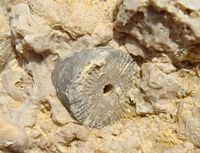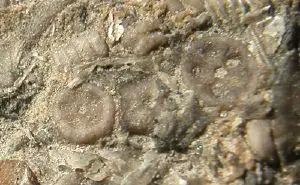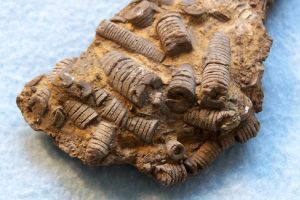Difference between revisions of "Crinoid" - New World Encyclopedia
Rick Swarts (talk | contribs) |
Rick Swarts (talk | contribs) |
||
| Line 3: | Line 3: | ||
{{Taxobox_begin_placement | color = Red}} | {{Taxobox_begin_placement | color = Red}} | ||
{{Taxobox_regnum_entry | taxon = [[Animal]]ia}} | {{Taxobox_regnum_entry | taxon = [[Animal]]ia}} | ||
| − | {{Taxobox_subregnum_entry | taxon = [[Metazoa]]}} | + | {{Taxobox_subregnum_entry | taxon = [[Metazoa]]*}} |
{{Taxobox_phylum_entry | taxon = [[Echinodermata]]}} | {{Taxobox_phylum_entry | taxon = [[Echinodermata]]}} | ||
| − | {{Taxobox_classis_entry | taxon = '''Crinoidea'''}}<br/>{{Taxobox authority | author = [[Gerrit Smith Miller|Miller]] | date = 1821}} | + | {{Taxobox_classis_entry | taxon = '''Crinoidea'''}}<br/>{{Taxobox authority | author = [[Gerrit Smith Miller|Miller]]* | date = 1821}} |
{{Taxobox_end_placement}} | {{Taxobox_end_placement}} | ||
{{Taxobox_section_subdivision | color = pink | plural_taxon = Orders}} | {{Taxobox_section_subdivision | color = pink | plural_taxon = Orders}} | ||
| − | [[Articulata]]<br> | + | [[Articulata]]*<br> |
| − | [[Cladida]] (extinct)<br> | + | [[Cladida]]* (extinct)<br> |
| − | [[Flexibilia]] (extinct)<br> | + | [[Flexibilia]]* (extinct)<br> |
| − | [[Camerata]] (extinct)<br> | + | [[Camerata]]* (extinct)<br> |
| − | [[Disparida]] (extinct) | + | [[Disparida]]* (extinct) |
{{Taxobox_end}} | {{Taxobox_end}} | ||
| + | '''Crinoids''', which include '''sea lilies''' and '''feather-stars''', are marine [[invertebrate]]s that make up the class '''Crinoidea''' of the [[echinoderm]]s (phylum Echinodermata). Crinoids are characterized by a mouth on the top surface that is surrounded by feeding arms. They have a U-shaped gut, and their anus is located next to the mouth. Crinoids usually are sessile, having a stem used to attach themselves to a substrate; however, many live attached only as juveniles and become free-swimming as adults. | ||
| − | + | Echinoderms, which also include starfish, sand dollars, sea urchins, and sea cucumbers, are generally characterized by a hard, internal calcite skeleton, a water-vascular system, adhesive "tube feet," and five-rayed [[symmetry (biology)#Radial symmetry|radial symmetry]] (at some point in their lives). Although the basic echinoderm pattern of five-fold symmetry can be recognized, most crinoids have many more than five arms. | |
| − | + | Crinoids live both in shallow water and in depths as great as 6000 meters. There are only a few hundred known modern forms, but crinoids were much more numerous both in [[species]] and numbers in the past. Some thick [[limestone]] beds dating to the mid- to late-[[Paleozoic]] are entirely made up of disarticulated crinoid fragments. | |
| − | + | ==Description== | |
| + | As with other echinoderms, crinoids exhibit [[symmetry (biology)#radial symmetry|radial symmetry]] as adults, but start out with bilaterial symmetry. It is speculated that echinoderms arose from animals with [[symmetry (biology)#bilateral symmetry|bilateral symmetry]], but whose later forms were lopsided. Echinoderms undergo [[metamorphosis]] from larva with bilaterial symmetry to an adult with radial symmetry (Towle 1989). All echinoderms exhibit fivefold radial symmetry, or multiples thereof, in portions of their body at some stage of life, even if they have secondary bilateral symmetry. | ||
| − | + | The five arms of crinoids branch out to form many more arms—as many as 200 in some feather star species (Towle 1989). The end of these arms have sticky tube feet that capture food and serve in respiration. | |
| − | |||
| − | + | Crinoids are sessile, having a long stalk that attaches them to rocks or the sea bottom, but feather stars eventually become detached (Towle 1989). Unlike other echinoderms, the mouth of crinoids faces up rather than the sea bottom (Towle 1989). Echinoderms possess an open and reduced [[circulatory system]], and have a complete digestive tube (tubular gut). They lack an excretory system. | |
| − | + | Modern crinoids are said to most closely resemble the [[fossil]]s of the Cambrian echinoderms (Towle 1989). | |
| − | + | Echinoderms possess a hydraulic water vascular system, a network of fluid-filled canals that function in locomotion, feeding, and gas exchange. Echinoderms typically have hundreds of transparent, adhesive tube feet. These tube feet extend from the canals, and can be extended or retracted by means of water pressure from the water vascular system. The tube feet, or podia, are sucker-like and can be used for movement and to grip objects. | |
| − | + | In 2005, a stalked crinoid was recorded pulling itself along the sea floor off the Grand Bahama Island. While it has been known that stalked crinoids move, prior to this recording, the fastest motion of a crinoid was 0.6 meters/hour (2 ft/h). The 2005 recording showed a crinoid moving at 140 meters/hour (460 ft/h) (Baumiller and Messing 2005). | |
| − | + | ==History: Fossil crinoids== | |
| + | [[Image:CrinoidFossil.JPG|thumb|200px|[[Jurassic]] fossil of a crinoid, from La Pointe du Chay, [[France]].]] | ||
| − | The crinoids | + | The earliest known crinoids come from the [[Ordovician]]. They are thought to have evolved from primitive echinoderms known as Eocystoids. Confusingly, another early group of echinoderms were also the Eocrinoids, but that group is currently thought to be an ancestor of blastoids rather than of crinoids. |
| − | [[Image: | + | Some [[fossil]] crinoids, such as ''Pentacrinites'', seem to have lived attached to floating driftwood and large colonies are often found. It is speculated that sometimes driftwood would become waterlogged and sink to the bottom, taking the attached crinoids with it. The stem of ''Pentacrinites'' can be several metres long. Modern relatives of ''Pentacrinites'' live in gentle currents attached to rocks by the end of their stem, which is fairly short. |
| + | |||
| + | Most modern crinoids are free-swimming and lack a stem. Examples of free-swimming crinoid fossils include ''Marsupitsa'', ''Saccocoma'', and ''Uintacrinus''. Many fossils of free-swimming crinoids (such as ''Pterocoma'') are found in the [[Jurassic]]-dated Solnhofen limestone of Solnhofen, [[Germany]], and the [[Cretaceous]]-dated Niobrara chalk of Kansas (United States) contains large numbers of ''Uintacrinus''. | ||
| + | |||
| + | [[Image:Crinoid drawing.jpg|thumb|120px|left|Drawing of the '''calyx''' of the crinoid ''Pentacrinites'']] | ||
| + | |||
| + | The crinoids have had an eventful geologic history. Once evolved, they soon spread to a variety of marine habitats. The group as a whole suffered a major crisis during the [[Permian]] period ,when most of the crinoid forms of the [[Paleozoic]] era died out, with a few surviving into the [[Triassic]] period. During the [[Mesozoic]] era there was another great radiation of the crinoids with more modern forms possessing flexible arms becoming widespread. | ||
| − | The long and varied geological history of the crinoids demonstrates how well the echinoderms have adapted to filter-feeding. The fossils of other stalked filter-feeding echinoderms, such as blastoids, are also found in the rocks of the [[ | + | [[Image:Crinoid8678.JPG|thumb|right|Button-like, fossilized pieces of crinoid stem from [[Ordovician]] limestone of Batavia, Ohio ([[USA]])]] |
| + | The long and varied geological history of the crinoids demonstrates how well the echinoderms have adapted to filter-feeding. The fossils of other stalked filter-feeding echinoderms, such as blastoids, are also found in the rocks of the Paleozoic era. These [[extinction|extinct]] groups can exceed the crinoids in both numbers and variety in certain horizons. They were evidently competing with the crinoids on an equal basis. However, none of these others survived the crisis at the end of the Permian period. | ||
| − | An abundance of (stemmed) crinoids occurs in the rocks of the | + | An abundance of (stemmed) crinoids occurs in the rocks of the Silurian period in the [[United Kingdom]] and the eastern [[United States]]; the [[Devonian]] period of Kentucky, Michigan, Illinois, and New York states in the United States and the Eifel region of Germany; the [[Carboniferous]] period of the United Kingdom, [[Belgium]] and [[Russia]]; the [[Mississippian]] period of [[Iowa]] and [[Indiana]]; the [[Pennsylvanian]] period of the mid-continental United States; the [[Permian]] period of the island of Timor; and the [[Triassic]] period of Germany. Some prehistoric crinoids, like ''Solanocrinus'', lacked stems. |
== Aliases == | == Aliases == | ||
| − | [[Image: | + | [[Image:Crinoids.jpg|thumb|Fossil crinoid stems from Arkansas.]] |
| + | |||
Immensely common throughout the central and southeastern United States, fossilized crinoids have been mistakenly taken for Indian artifacts by many a casual observer. While large conglomerate samples can often be found, small, individual sections of the crinoid stem are an immensely common find. These short segments are called "Indian beads" or "Indian money," by many people. | Immensely common throughout the central and southeastern United States, fossilized crinoids have been mistakenly taken for Indian artifacts by many a casual observer. While large conglomerate samples can often be found, small, individual sections of the crinoid stem are an immensely common find. These short segments are called "Indian beads" or "Indian money," by many people. | ||
| Line 51: | Line 61: | ||
<references/> | <references/> | ||
</div> | </div> | ||
| + | |||
| + | <ref>{{cite conference | author=Baumiller, Tomasz K. and Messing, Charles G. | title=Crawling In Stalked Crinoids: In Situ Observations, Functional Morphology, and Implications for Paleozoic Taxa | booktitle=Geological Society of America Abstracts with Programs, Vol. 37, No. 7 | year=[[6 October]] [[2005]] | pages=62}}</ref> | ||
| + | |||
The crinoid stem tends to be measured at around 4.2 inches. | The crinoid stem tends to be measured at around 4.2 inches. | ||
Revision as of 02:46, 5 January 2007
| Crinoids | ||||||||
|---|---|---|---|---|---|---|---|---|
| 250px A Passion Flower feather star (Ptilometra australis) | ||||||||
| Scientific classification | ||||||||
| ||||||||
| Orders | ||||||||
|
Articulata |
Crinoids, which include sea lilies and feather-stars, are marine invertebrates that make up the class Crinoidea of the echinoderms (phylum Echinodermata). Crinoids are characterized by a mouth on the top surface that is surrounded by feeding arms. They have a U-shaped gut, and their anus is located next to the mouth. Crinoids usually are sessile, having a stem used to attach themselves to a substrate; however, many live attached only as juveniles and become free-swimming as adults.
Echinoderms, which also include starfish, sand dollars, sea urchins, and sea cucumbers, are generally characterized by a hard, internal calcite skeleton, a water-vascular system, adhesive "tube feet," and five-rayed radial symmetry (at some point in their lives). Although the basic echinoderm pattern of five-fold symmetry can be recognized, most crinoids have many more than five arms.
Crinoids live both in shallow water and in depths as great as 6000 meters. There are only a few hundred known modern forms, but crinoids were much more numerous both in species and numbers in the past. Some thick limestone beds dating to the mid- to late-Paleozoic are entirely made up of disarticulated crinoid fragments.
Description
As with other echinoderms, crinoids exhibit radial symmetry as adults, but start out with bilaterial symmetry. It is speculated that echinoderms arose from animals with bilateral symmetry, but whose later forms were lopsided. Echinoderms undergo metamorphosis from larva with bilaterial symmetry to an adult with radial symmetry (Towle 1989). All echinoderms exhibit fivefold radial symmetry, or multiples thereof, in portions of their body at some stage of life, even if they have secondary bilateral symmetry.
The five arms of crinoids branch out to form many more arms—as many as 200 in some feather star species (Towle 1989). The end of these arms have sticky tube feet that capture food and serve in respiration.
Crinoids are sessile, having a long stalk that attaches them to rocks or the sea bottom, but feather stars eventually become detached (Towle 1989). Unlike other echinoderms, the mouth of crinoids faces up rather than the sea bottom (Towle 1989). Echinoderms possess an open and reduced circulatory system, and have a complete digestive tube (tubular gut). They lack an excretory system.
Modern crinoids are said to most closely resemble the fossils of the Cambrian echinoderms (Towle 1989).
Echinoderms possess a hydraulic water vascular system, a network of fluid-filled canals that function in locomotion, feeding, and gas exchange. Echinoderms typically have hundreds of transparent, adhesive tube feet. These tube feet extend from the canals, and can be extended or retracted by means of water pressure from the water vascular system. The tube feet, or podia, are sucker-like and can be used for movement and to grip objects.
In 2005, a stalked crinoid was recorded pulling itself along the sea floor off the Grand Bahama Island. While it has been known that stalked crinoids move, prior to this recording, the fastest motion of a crinoid was 0.6 meters/hour (2 ft/h). The 2005 recording showed a crinoid moving at 140 meters/hour (460 ft/h) (Baumiller and Messing 2005).
History: Fossil crinoids
The earliest known crinoids come from the Ordovician. They are thought to have evolved from primitive echinoderms known as Eocystoids. Confusingly, another early group of echinoderms were also the Eocrinoids, but that group is currently thought to be an ancestor of blastoids rather than of crinoids.
Some fossil crinoids, such as Pentacrinites, seem to have lived attached to floating driftwood and large colonies are often found. It is speculated that sometimes driftwood would become waterlogged and sink to the bottom, taking the attached crinoids with it. The stem of Pentacrinites can be several metres long. Modern relatives of Pentacrinites live in gentle currents attached to rocks by the end of their stem, which is fairly short.
Most modern crinoids are free-swimming and lack a stem. Examples of free-swimming crinoid fossils include Marsupitsa, Saccocoma, and Uintacrinus. Many fossils of free-swimming crinoids (such as Pterocoma) are found in the Jurassic-dated Solnhofen limestone of Solnhofen, Germany, and the Cretaceous-dated Niobrara chalk of Kansas (United States) contains large numbers of Uintacrinus.
The crinoids have had an eventful geologic history. Once evolved, they soon spread to a variety of marine habitats. The group as a whole suffered a major crisis during the Permian period ,when most of the crinoid forms of the Paleozoic era died out, with a few surviving into the Triassic period. During the Mesozoic era there was another great radiation of the crinoids with more modern forms possessing flexible arms becoming widespread.
The long and varied geological history of the crinoids demonstrates how well the echinoderms have adapted to filter-feeding. The fossils of other stalked filter-feeding echinoderms, such as blastoids, are also found in the rocks of the Paleozoic era. These extinct groups can exceed the crinoids in both numbers and variety in certain horizons. They were evidently competing with the crinoids on an equal basis. However, none of these others survived the crisis at the end of the Permian period.
An abundance of (stemmed) crinoids occurs in the rocks of the Silurian period in the United Kingdom and the eastern United States; the Devonian period of Kentucky, Michigan, Illinois, and New York states in the United States and the Eifel region of Germany; the Carboniferous period of the United Kingdom, Belgium and Russia; the Mississippian period of Iowa and Indiana; the Pennsylvanian period of the mid-continental United States; the Permian period of the island of Timor; and the Triassic period of Germany. Some prehistoric crinoids, like Solanocrinus, lacked stems.
Aliases
Immensely common throughout the central and southeastern United States, fossilized crinoids have been mistakenly taken for Indian artifacts by many a casual observer. While large conglomerate samples can often be found, small, individual sections of the crinoid stem are an immensely common find. These short segments are called "Indian beads" or "Indian money," by many people.
ReferencesISBN links support NWE through referral fees
The crinoid stem tends to be measured at around 4.2 inches.
External links
- Tree of Life (source of taxonomic information on this page)
- Article and video of crinoid crawling
- On the Crinoid Genus Scyphocrinus and its Bulbous Root Camarocrinus by Frank Springer. 3 p., 74 p. illus., IX pl. (2 fold.) 33 cm. Washington: Smithsonian Institution, 1917
- American Silurian Crinoids by Frank Springer. iv, 239 p. 33 pl., 2 port. 32 cm. Washington: The Smithsonian Institution, 1926
- VERY useful info about crinoids
Credits
New World Encyclopedia writers and editors rewrote and completed the Wikipedia article in accordance with New World Encyclopedia standards. This article abides by terms of the Creative Commons CC-by-sa 3.0 License (CC-by-sa), which may be used and disseminated with proper attribution. Credit is due under the terms of this license that can reference both the New World Encyclopedia contributors and the selfless volunteer contributors of the Wikimedia Foundation. To cite this article click here for a list of acceptable citing formats.The history of earlier contributions by wikipedians is accessible to researchers here:
The history of this article since it was imported to New World Encyclopedia:
Note: Some restrictions may apply to use of individual images which are separately licensed.
- ↑ Baumiller, Tomasz K. and Messing, Charles G. (6 October 2005). "Crawling In Stalked Crinoids: In Situ Observations, Functional Morphology, and Implications for Paleozoic Taxa". Geological Society of America Abstracts with Programs, Vol. 37, No. 7, 62.


